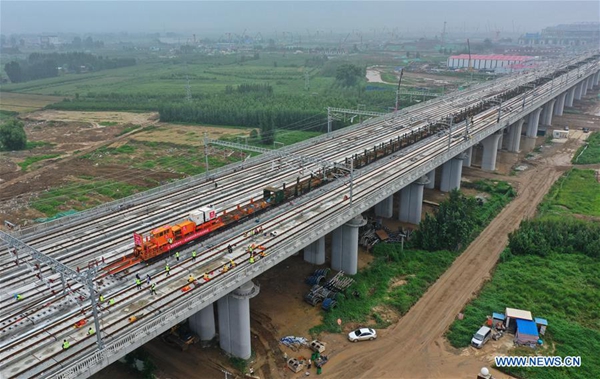Xiong'an: Exploring China's futuristic city
- By Jiao Yongli
 0 Comment(s)
0 Comment(s) Print
Print E-mail China.org.cn, October 12, 2020
E-mail China.org.cn, October 12, 2020

Established in April 2017, Xiong'an New Area, about 100 kilometers southwest of Beijing, is a key step in the country's regional development strategy. Xiong'an will be built into a "city of the future," and its planning process demonstrates a systematic exploration of a new urban development paradigm.
All over the world, projects such as "Google Sidewalk Toronto" and "London 2062" are exploring future city systems. In China, cities and new districts are building futuristic sub-cities and urban areas. These practices show that, facing a technological revolution, futuristic cities are becoming a new area of competition. China is pushing for a "Chinese solution" for top-level designs and local practices to explore futuristic city development.
At present, China's development is shifting from high speed to high quality. High quality development focuses on the supply side, which requires innovation and growth as the core driving force. From the perspective of economic operations, high-quality development means the need to produce high-quality products and services, which are supported by high-quality economic and commercial ideas. Therefore, the new era calls for high-quality urban development models and governance ideas. The development of futuristic cities provides direction and space for imagination.
The science and technology revolution will bring about tremendous changes in industrial development, city forms, and social governance. At the same time, the institutional advantages of socialism with Chinese characteristics will also promote the development of the industrial revolution. Together, the two will stimulate a system-integrated futuristic city plan. In this process, the logic of interaction between technologies, industries and cities will undergo profound changes, while industry, planning, and governance will increasingly influence each other and interact closely.
When we observe Xiong'an, we can do so from a regional and national perspective. From a regional perspective, the Xiong'an New Area is derived from the national strategy of the coordinated development of the Beijing-Tianjin-Hebei region. From a national perspective, in the face of a new round of technology industry reform, the cultivation of a new regional growth must have distinctive characteristics.
Planners for the Xiong'an New Area have proposed the idea of building a "digital twin city." The real and virtual cities will be constructed simultaneously and mutually promoted. Its planning also takes people, nature, urban space and innovative activities into consideration, forming a superposition of the three systems of "natural ecology, human settlement ecology, and innovation ecology."
Behind this is a profound change in thinking, which is the leap from industrial civilization to an ecological civilization. An ecological civilization is by no means only about increasing ecological and environmental protection, it also means upgrading the entire city's operating system. The futuristic city will become an "industry incubator" and an "application integration field" of various cutting-edge technologies. These two aspects together constitute the futuristic attributes of the futuristic city.
The futuristic city can be understood with two aspects. The first is the change of the city itself, including the city form, function, layout, and structure. The new science and technology industrial revolution will trigger groundbreaking changes in many fields, and will relax various constraints of contemporary urban construction. The second is governance reform, including investment and financing, land and social governance. The two aspects need to be completely integrated. China has unique institutional advantages and a technological basis to run alongside the international community.
Technological innovation can solve various challenges faced by cities, but innovation is by no means limited to technology. Smarter systems and policies can make cities run more efficiently. Therefore, technological innovation and urban optimization are ultimately intended to improve human well-being.
We can be sure that the innovation of the science and technology industry will cause systemic changes, bringing opportunities and challenges; major technologies, especially new technologies and new infrastructures, will have a major impact on the urban form. These trends remind us to return to the basic model of the city to find a more inclusive theoretical path, and find a theoretical city model that can tolerate the interaction of technology and system.
In the era of ecological civilization and the information age, to move forward to the futuristic city requires a systematic upgrade of urban governance, rather than a simple application of technologies. So, I have following suggestions:
First, focus on integration and build a theoretical framework for the futuristic city. The first level of integration is the integrated analysis and understanding the comprehensive impact of the technology industry reform on the city. The second level of integration is an integrated analysis of the impact of the technology industry and the governance response.
Second, strengthen the top-level design to face the new vision of the technology industry transformation. Based on the analysis of several major changes in futuristic cities through theoretical research and judgment, a new system of theories, concepts, systems, and policies will be built, and a whole set of thinking in the new era will be used to plan and build futuristic cities.
Third, embrace the technological revolution and improve the large-scale agility of urban governance. In our current urban governance system, most governments are still stuck in the information feedback model from the previous industrial age.
All in all, the development and governance of futuristic cities require theoretical reconstruction, conceptual transformation, field expansion, method changes, and innovation. On the basis of the accumulation of many short-term frameworks we can see, further system integration and upgrades should be made. I believe that China's futuristic city urban practices can contribute a holistic "Chinese solution" to the world.
Dr. Jiao Yongli is an associate professor of China Executive Leadership Academy Pudong (CELAP).
Opinion articles reflect the views of their authors only, not necessarily those of China.org.cn.
If you would like to contribute, please contact us at opinion@china.org.cn.





